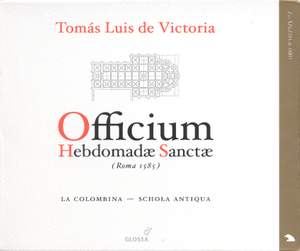Victoria: Officium Hebdomadae Sanctae (Office for Holy Week)
La Colombina & Schola Antiqua, Juan Carlos Asensio
Victoria's massive publication of 1585, the OfficiumHebdomadae Sanctae, was never intended as a self-contained 'work': alongside the famous Tenebrae settings, it includes Lamentations for the... — More…
Downloads
What are FLAC and MP3?Contents
Victoria: Vexilla regis more hispano
Work length8:45
$2.00
$2.60
- Colombina, La
anon.: Hosanna filio David
Work length0:42
$1.00
$1.30
- Schola Antiqua
- Juan Carlos Asensio
Victoria: Pueri hebraeorum vestimenta
Work length2:14
$1.00
$1.30
- Colombina, La
Victoria: Passio secundum Matthaeum
Work length18:00
$4.00
$5.15
- Colombina, La
Victoria: O Domine Jesu Christe
Work length2:36
$1.00
$1.30
- Colombina, La
anon.: Zelus domus tuae
Work length1:13
$1.00
$1.30
- Schola Antiqua
- Juan Carlos Asensio
anon.: Avertantur retrorsum et erubescant
Work length0:20
$1.00
$1.30
- Schola Antiqua
- Juan Carlos Asensio
Victoria: Incipit lamentatio Jeremiae
Work length5:32
$1.00
$1.30
- Colombina, La
Victoria: Et egressus est
Work length5:08
$1.00
$1.30
- Colombina, La
Victoria: Manum suam
Work length6:03
$1.00
$1.30
- Colombina, La





